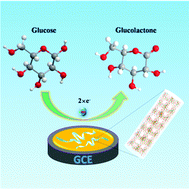Xiao Xiao, Shasha Zheng, Xinran Li, Guangxun Zhang, Xiaotian Guo, Huaiguo Xue and Huan Pang
J. Mater. Chem. B, 2017,5, 5234-5239
DOI:
10.1039/C7TB00180K,
Paper
Ultrathin Ni-MOF nanobelts, [Ni20(C5H6O4)20(H2O)8]·40H2O(Ni-MIL-77 NBs), were synthesized by a facile one-pot solution process and can be used as an efficient catalyst electrode for glucose oxidation under alkaline conditions. Electrochemical measurements demonstrate that the NB/GCE, when used as a non-enzymatic glucose sensor, offers superior analytical performances with a wide linear range (from 1 μM to 500 μM), a low detection limit (0.25 μM, signal-to-noise = 3), and a response sensitivity of 1.542 μA mM−1 cm−2. Moreover, it can also be applied for glucose detection in human blood serum with the relative standard deviation (RSD) of 7.41%, showing the high precision of the sensor in measuring real samples.
